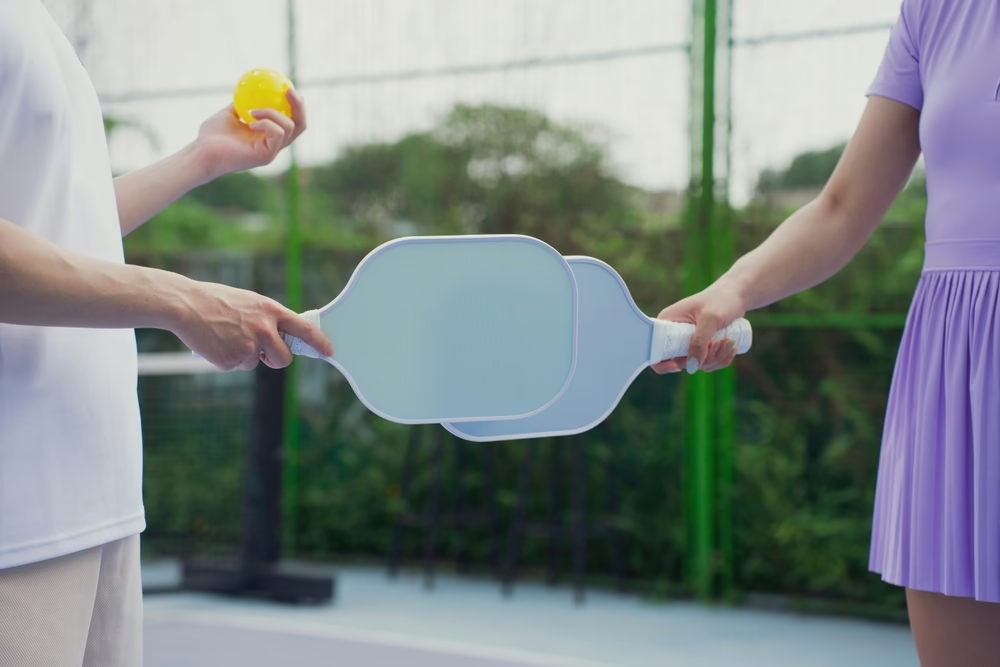Signs It’s Time to Resurface Your Pickleball Court
Read More

Before you break ground, you need a plan that balances vision and practicality. A modern court isn’t just about function; it should look intentional, integrate nicely into your property, and stand the test of time. Pickleball court construction in Virginia delivers a professionally designed, durable playing surface ideal for both recreational and competitive use.
Start by talking to your township to learn what’s allowed on your property and what permits you’ll need before breaking ground. Once you understand the local requirements, begin visualizing how your court will relate to your home, yard, and views. Even though the playable area must be 20 ft × 44 ft, you want breathing space around it. A 30 × 60 ft footprint is the bare minimum; for that “designed” feel, go for 34 × 64 ft or larger. That gives you room for styling, walking paths, and safety zones. Think about how the court looks from your home or patio—you want clean sightlines, balance, and integration with landscaping. Don’t forget underground constraints: check for utility lines, soil type, slope, drainage paths, and how the court will transition into surrounding terrain.
Design features cost more. So when you budget:
Your total cost will hinge heavily on whether you choose basic materials or push toward a designer finish.
Begin by carving out a clean, sharply edged footprint. Remove grass, rocks, roots and make boundaries crisp. Grade the site with a subtle slope to manage drainage without creating harsh transitions. The edges where the court meets the landscape should be clean, considering concrete edging or paved transition zones. Excavate to proper depth (4–6 inches or more, depending on base) with uniform depth so the base layers sit true.
Your foundation decisions affect surface flatness, longevity, and aesthetics.
Make sure your base is compacted, level, and uniform before moving to the next stage.
Once the base cures (28 day cure time):
The goal: a surface that is both a pleasure to play on and visually striking.
Precision is essential. Lines should all be 2 inches wide as per regulation. Use high-quality sport-court line paint with strong contrast to the court color. Mask lines carefully and use line-striping tools or machines to prevent bleeding. Clean, crisp edges are part of the aesthetic. Modern design often favors minimal but bold lines to avoid overly elaborate or cluttered linework.
The hard surface is done, now you layer in hardware and aesthetic features.
Permanent, in-ground net posts look more refined than portable nets. Use slim, powder-coated steel posts set in concrete footings. Conceal cables internally if possible, so the hardware doesn’t dominate the visual field. Make sure you have a regulation post spacing (22 ft) and net height (36 in at sidelines, 34 in at center). Choose tension systems (crank, internal cable) that help maintain clean tension without sagging.
Integrate the lighting plan early: pole locations, wiring paths, and fixture design affect how the court will read at dusk and night.
Design-oriented touches elevate your court:
These are details that make your court feel polished, not just functional.
A modern court should stay sharp for years and maintenance preserves both appearance and performance.
With design features included, expect 8 weeks. The curing of asphalt (often ~28 days) and inspections often define the schedule.
Yes, many modern courts are conversions. Because the slab is already in place, your focus will shift to repairing, surfacing, and styling. You may convert one tennis court into multiple pickleball courts.
Non-cushioned courts are standard acrylic layers over the base. Cushioned courts add a rubberized or shock-absorbent layer beneath, which enhances player comfort and gives a more premium feel.
Leave at least 8-10 feet between courts. For a modern layout, maintain consistent spacing, align fences and lighting, and preserve circulation paths to avoid visual clutter.
Pickleball court construction in New Jersey creates a high-quality, long-lasting surface tailored for players of all skill levels. You’re tackling a major project but one that can transform your backyard into a stunning, high-performance asset.
With intentional design decisions, sleek finishes, and thoughtful detailing, your pickleball court can be more than a court: it can be a signature feature of your property. Let me know if you’d like to go next into polishing, adding images, callout boxes, or a final version! Call us today for more information.